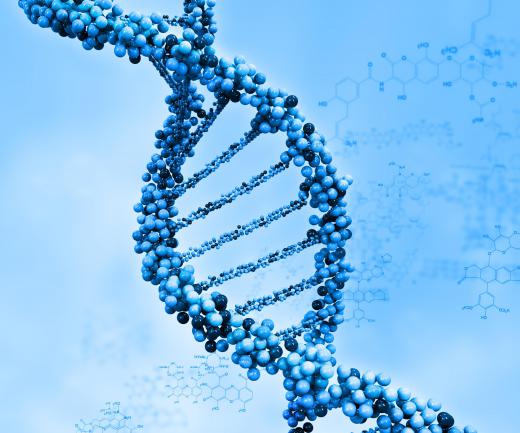What is Adenosine Triphosphate?
 Niki Foster
Niki Foster
Adenosine triphosphate (ATP) is a nucleotide, a type of molecule that makes up deoxyribonucleic acid (DNA) and ribonucleic acid (RNA), the building blocks of genetic material. When it is not part of an RNA or DNA molecule, ATP serves to transport chemical energy within cells for various metabolic purposes. Some mechanisms for which ATP is essential are the synthesis of chemical compounds such as proteins, cell motility or movement, and cell division. Adenosine triphosphate is made of other nucleotides, adenosine diphosphate (ADP) or adenosine monophosphate (AMP), and when it takes part in metabolic functions, it reverts to these precursors.
This substance consists of adenosine, made of the nucleobase adenine and an attached ribose sugar, and three phosphates, the alpha, beta, and gamma phosphates. In plants, it is created through photosynthesis, which uses sunlight as an energy source and converts carbon dioxide into sugar. In animals, ATP is created through cellular respiration, which typically uses oxygen to convert glucose into carbon dioxide and water. Cellular respiration can also take place in the absence of oxygen, in which case it is called glycolysis or anaerobic respiration and the product is pyruvic acid.
Adenosine triphosphate is stored energy. It becomes active when broken down by hydrolysis, the insertion of water molecules between its chemical bonds. Hydrolysis results in one of the phosphates of ATP becoming detached, releasing energy.

ATP is the most important source of energy for intracellular activities. It is responsible for most anabolic reactions, in which precursor molecules are joined together into larger molecules. Some examples include protein assembly; assembly of some of the component parts of DNA and RNA; and the synthesis of fats and polysaccharides, a group of carbohydrates.

It is also responsible for active transport, in which materials are pumped into or out of cells across the cellular membrane. It also helps maintain ideal fluid volume within the cell and helps send signals between cells. The transmission of information through the nervous system and the contraction of muscles are also reliant on ATP.
The beating of flagella and cilia is also conducted by adenosine triphosphate. These actions have many functions, including the movement of food through the digestive tract and the motility of sperm. ATP is also responsible for bioluminescence, the ability of some organisms, like fireflies and angler fish, to emit light.
AS FEATURED ON:
AS FEATURED ON:

















Discussion Comments
I studied the ATP molecule and how it provides the human body with energy when I took biology in high school, and again in college, but it never quite made sense to me. However, one thing I do recall of importance is that people should rely as little on old, stored energy as possible- if you haven't had enough to eat or drink and you try to do something active, your body will have to rely on fermenting lactic acid instead, which provides energy at a much less reliable rate, and is why people get cramps from lactic acid.
Post your comments